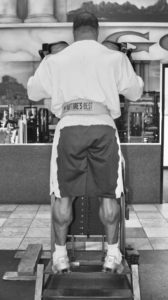
Strength Sensei CP
Ballet dancers and volleyball players often have exceptional calves from the explosive nature of their workouts. You can use this knowledge to help you break through training plateaus in calf development.
Encountering plateaus in calf development is frustrating and quite common. If standard resistance training protocols fail to bring results, what you need is a change of pace. And explosive calf training with jump squats may be just the thing, especially if you have done conventional calf training for long periods. I’ve seen gains of as much as 1.25 inches in calf circumference in two months with explosive calf work.
Explosive calf training creates a high level of stress, so it’s especially important to warm up with progressively heavier sets of full-range standing calf raises. But again, this is a warm-up — don’t go to failure.
For your primary exercise, load a barbell to 25 percent of your bodyweight. Rest it across your shoulders as you would in a squat. As an alternative overload implement, you can use a sandbag with handles. You want to stay away from doing jump squats with dumbbells. Upon landing, the dumbbells will place undue stress on the soft tissue and joint structures of the shoulder girdle.
Jump up and down for a set of 12 reps. Rest two minutes between sets and perform five sets. Make certain the ground contact is kept to a minimum and go for maximal height, keeping the involvement of the knee extensors to a minimum. The hypertrophy and strength gains in your calves will come from the fast eccentric loading caused by the landings. It is not much work on paper, but the rewards will be appreciable.
 A warm-up for explosive calf training should include several sets of progressively heavier standing calf raises. (Miloš Šarčev photo)
A warm-up for explosive calf training should include several sets of progressively heavier standing calf raises. (Miloš Šarčev photo)
One very important tip: With this exercise, air time is more important than load. Do not go for heavy loads, but for air time. The problem with this exercise is many trainees used loads that far exceed their stretch-shortening cycle capabilities. In other words, they spend way too much time on the ground, which negates the positive transfer of this exercise. Jump squats performed with too much load do not provide sufficient acceleration and have excessive ground contact time, defeating the purpose of this exercise.
I prefer to have my clients use the same load on the barbell for six workouts and NOT to increase the weight for the duration of the cycle. I want them to concentrate on accelerating the barbell and being consistent with each landing. In athletes with structural balance issues or those plagued with coordination problems, the landing patterns are often different from one rep to another. For example, someone whose knees buckle in for the pre-loading and landing of jump squats is definitely not ready for jump squats.
After completing six workouts of 5 straight sets of 12 reps, you can do another six workouts with a drop set format. Jump for 6 reps with a barbell representing 30 percent of bodyweight, put the barbell on the floor (or return it to squat racks), and immediately perform another 6 reps with just your bodyweight. Do 5 drop sets, resting 3 minutes between drop sets.
Success leaves clues, and this motto holds true for calf training. Take a hint from the exceptional calf development of athletes in other sports and give explosive calf training a shot.
